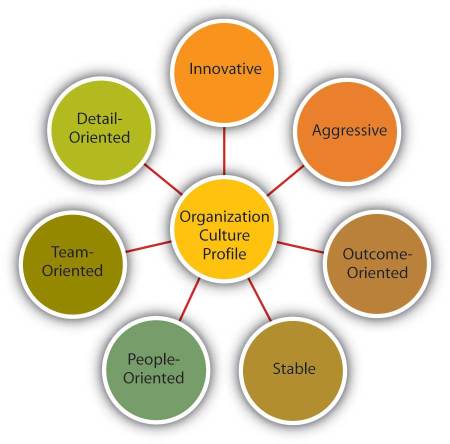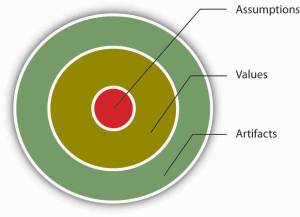1. Preface
The reason why I choose to write about organizational culture in my first post is because I think that it is one of the key factors that contributes to the success or failure of an organization. People talk about organizational culture all the time: in casual discussions between co-workers, in formal speeches given by a CEO, in interviews, etc… but from my experience, not all of us have a clear understanding about it. Such questions as “What is organizational culture? How can we identify it? How can we measure or evaluate it?” are still a myth to some people.
The purpose of this post (and other similar posts after this) is to help the readers to gain more knowledge about organizational structure. What will be presented here is a combination of what I learn, read and experienced.
2. What is organizational culture?
- How do people dress? Formal or casual?
- Is it appropriate to argue with the boss in public?
- Is it normal to work overtime?
- Is it important to check email regularly during weekend?
- Is it normal to take risk?
- How are people rewarded or promoted?
- … and many more things

So the scope of what define an organizational culture is broad. But where are they “stored”? Where are they “contained” or documented? According to Bauer and Erdogan (2009), an organizational culture is “contained” at three levels: assumptions, values and artifacts.
- Logo
- Slogan
- Policies, rules and procedures
- Guidelines
- Reward system
- Workflow and process
- Organizational structure and titles
- Orientation plan
- Training programs
- Physical environment
- Office layout
- Employee interaction
3. Key dimension of organizational culture
- Individual autonomy: the level of responsibility, independence and empowerment that an individual has in the organization.
- Structure: the number of rules and regulations, the number of hierarchical levels in the organizational structure.
- Support: the degree of assistance provided by managers to their subordinates.
- Identification: the level of proudness that members have to be part of the organization.
- Performance reward: the degree to which reward allocations (promotions, salary increases, bonus…) are based on performance criteria.
- Conflict tolerance: the level of conflict exists in the relationships between members of the organization.
- Risk tolerance: the degree to which employees are encouraged to be aggressive, innovative, and risk seeking.
4. Primary characteristics of organizational culture
Another approach to characterize an organizational culture is to use the OCP (Organizational Culture Profile) framework.

- Innovative: companies that have innovative cultures are flexible, adaptable, and experiment with new ideas. They usually have flat structure in which titles and other status distinctions tend to be downplayed. Examples for this are startup software companies.
- Aggressive: companies with aggressive cultures encourage competitiveness and outperforming competitors. Such companies as Microsoft or Apple are good example of this type of culture.
- Outcome-oriented: cultures that focus on achievement, results, and actions. In such cultures, rewards are tied to performance indicators, not to seniority or loyalty. Best Buy is a good example in this case.
- Stable: cultures that are predictable, rule-oriented, and bureaucratic. Examples of this type of culture can be found in most of the public sector institutions.
- People-oriented: cultures that value fairness, supportiveness, and respect for individual rights. Company with this type of culture believe that people are their greatest asset and create an atmosphere where work is fun.
- Team-oriented: cultures that emphasize collaboration and cooperation among employees. In team-oriented organizations, members tend to have more positive relationships with their coworkers as well as their managers. Southwest Airlines can be a good example for this type of culture.
- Detail-oriented: cultures that focus on precision and paying attention to details. Examples for this are big hotels or McDonald’s Corporation.
5. Strong versus weak organizational culture
A strong organizational culture is the one that is aligned with the strategic plan of the company. In strong organizational cultures, all members have a consensus on the values that drive the organization. Researches have shown that strong organizational culture usually has positive impacts on performance of the organizations.
- Organizational members have no clear values or beliefs about how to succeed in their business.
- Organizational members have many beliefs as to how to succeed but cannot agree on which are most important.
- Different parts of the organization have fundamentally different beliefs about how to succeed.
- Those who personify the culture are destructive or disruptive and don’t build on any common understanding about what is important.
- The rituals of day-to-day organizational life are disorganized or working at cross-purposes.
6. Sources of organizational culture
- Founders and CEO: an organizational cultures are usually tied to the personality, background, and values of its founder or upper managers, especially during it early years.
- Industry determinants: industry characteristics and demands act as a force to create similarities among organizational cultures. For example, IT companies usually have innovative culture whereas companies in the insurance and banking industries are stable and rule-oriented.
- National or regional culture: the culture of the country or the area where the company is located also has significant influence on its organizational culture, mainly via its staffs. A US company and a Vietnamese company, despite the fact that they are in the same industry, will have some certain differences in their organizational cultures.
7. Conclusion
- Companies need to select people who fit into its organizational culture (and fire people who do not). People usually don’t change how they do things.
- 30% of company merging is failed due to collapse of culture.
- Organizational culture must be aligned with the strategic plan.
- Leaders (founder, CEO, Executive team…) are very important factors that drive the organizational culture. People always look up to see what their leaders are doing. As a result, leaders need to walk the talk.
8. References
Bess, D., 2012. Organization Culture, BUS 626 Organizational Behavior. University of Hawaii at Manoa, unpublished.
Bauer, T. and Erdogan, Berrin., 2009. Organizational Behavior. 1st ed. Flat World Knowledge, Inc.
Deal, T. and Kennedy, A., 2000. Corporate Cultures: The Rites and Rituals of Corporate Life. 1st ed. Basic Books.

Pingback: An appropriate organizational culture for a start-up software company | Agile Vietnam
Pingback: Interview questions to uncover organizational culture | Agile Vietnam
Pingback: Understanding conflict at workplace | Agile Vietnam
Pingback: Empowerment in organizations | Agile Vietnam